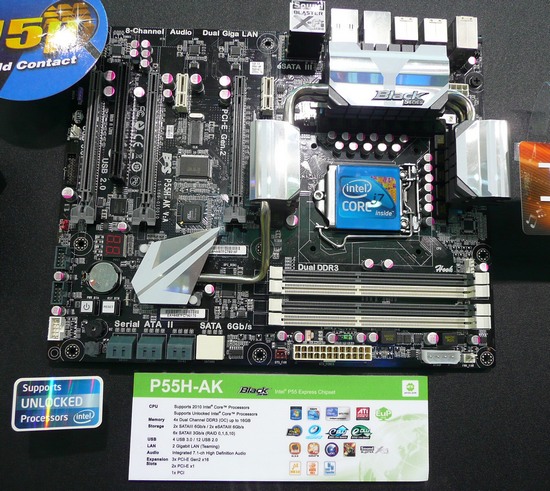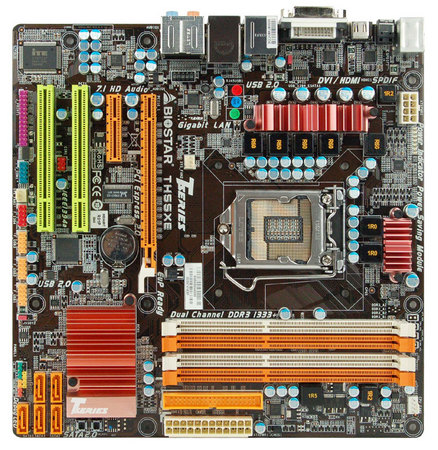Computex 2010: Motherboards
by Ian Cutress on June 16, 2010 12:36 PM EST- Posted in
- Trade Shows
- AMD
- Intel
- Motherboards
MSI P55A Fuzion
Lucid have been quite insistent on pushing their Hydra GPU Load Balancer chip onto MSI for a product to sell. Despite the nature of the drivers and lack of supported video game titles, MSI are releasing the P55A Fuzion, with an onboard Lucid Hydra chip, at some point this July we believe.

With a predicted price of $159, the Fuzion is essentially the little brother to the Big Bang Fuzion, but with USB 3.0 and SATA 6Gb/s. Against other P55 boards of similar price, this puts the P55A Fuzion in direct competition with the ASUS P7P55D-E and the Gigabyte GA-P55A-UD3P. However, this does make it the cheapest Lucid Hydra enabled motherboard on the market, should you wish to take the plunge.
ECS P55H-AK
ECS are desperately trying to break into consumer markets, so we were set upon with their new P55 board. As part of the ECS Black series, the PCB comes in pure black and white, and offers three PCIe x16 Gen 2.0 slots spaced for tri-GPU setups, 4 USB 3.0 slots, 2 SATA/eSATA 6Gb/s ports, dual Gigabit Ethernet ports, and 7.1 channel HD audio. Extra PCIe lanes come in the form of a PLX chip, located between the first and second PCIe slots.

What is most unusual about his motherboard is a 4-pin molex connector situated beside the DDR3 slots. Depending on the purpose of this molex connector (it seems in a weird position to provide extra power to the GPU layout or the CPU) this may or may not inconvenience users, depending on case and cable management.
Biostar TH55XE
The TH55XE from Biostar is an oddly coloured H55 micro-ATX board also on display at Computex. Using a black PCB with orange, white, and yellow components, this is board aimed at the HTPC market.

With support for Core i3/i5/i7 processors, 4 DDR3 DIMM slots and Realtek ALC888 8+2 Channel HD Audio, Biostar believe the motherboard could make a perfect combination for an in-home entertainment system. However, as seems to be the case constantly with Biostar, the combination of PCI and PCIe slots may not be to anyone’s taste. The PCIe x16, PCIe x1, PCI, PCI arrangement will frustrate users wanting an x1 audio card and a double slot or large passive GPU - we'd much rather like an PCIe x1, PCIe x16, PCI, PCI arrangement.










33 Comments
View All Comments
LoneWolf15 - Wednesday, June 16, 2010 - link
"ECS are desperately trying to break into consumer markets,"If they hadn't made nearly a decade of budget, sometimes complete garbage mainboards, I might consider them. Their past (some of it not that long ago) kills that.
Even good boards on paper, like the vaunted K7S5A some years back, were plagued by quality control issues during manufacturing, furthering this perception. I saw way too many ECS RMAs. The fact that they haven't stopped making cheapo mainboards either also dilutes the brand.
If ECS wants to succeed with the consumer or enthusiast market, they should create a new division dedicated to the quality gear, with a new brand name. Otherwise, their brand will continued to be marred by their low-end stuff, discouraging people from buying at the high-end.
jaydee - Wednesday, June 16, 2010 - link
I bought a K7S5A new and it was quite a board for the money at the time (I sold the system to a friend, as far as I know it's still running). I know they don't have the best rep, but based on that one experience I've had with them, I'd have no problems going with them again. That being said, I've never been in the market, nor ever see myself going for top-end enthusiast boards (by any maker). But for a low-end, middle of the road, I'd trust ECS.Samus - Wednesday, June 16, 2010 - link
Most of the problems ECS boards I ran into had were directly related to the use of VIA chipsets. The K7S5A was an exception to their poor quality because it was an SIS chipset which was undeniably more stable than VIA's competing chipsets and had far less IDE bugs. There was a great DMA patch SIS released to solve performance problems as well that worked like a charm.ECS boards based on nVidia and Intel chipsets have been equally as good as the SIS-based K7S5A. It's VIA that really tarnished their rep. When you look at the other brands from the VIA-era, in the end, they were all garbage. Few of them lasted more than a couple years before burning out or blowing caps. They were arguably never really stable. To pour salt on the wound, ECS traditionally used VIA's reference designs, too.
I've had good experience with ECS' Intel-based boards. Except for the crappy BIOS support.
MrSpadge - Wednesday, June 16, 2010 - link
Can't really blame the chipset for blowing caps, can you?Operandi - Thursday, June 17, 2010 - link
I've built tons of systems around VIA chipsets and never had problem with stability or reliability. In fact a couple of them have been running 24/7 since I built them in 01 - 02.The chipsets were solid and reliable if not performance leaders, stability and longevity is up to the motherboard manufacture building a good board. In fact I've seen more dead motherboards based on Intel chipsets than I have VIA based boards.
Redcharlie - Thursday, June 24, 2010 - link
I bought a K7S5A new on Sept 11, 2001, and it ran well for years, although I did have to update the BIOS to use a 160GB drive. It was a great board at a great price. I finally replaced it in 2008.Since buying the K7S5A I've bought boards from DFI, Gigabyte, and Asus, but have never seen a particular ECS board that stood out enough to tempt me. Glad to see them back in the ring.
chrnochime - Wednesday, June 16, 2010 - link
Well my crappy ECS board that has Nvidia 6150 chipset that I got from Fry's with the E2200 has seen the CPU oc'd to 2.9GHz, been on for at least 5 hours each day, for the last 2 years without any hardware problem or BSOD in windows vista. That cobbled together rig is actually much more stable than the one I put together as a temp HT/game PC with the Asus P5q pro and E8400, which thus far has encountered a bunch of random BSOD. Might have something to do with me using the Ati Tray Tool in Vista for the 4870, but then the same setup worked with the ECS board with no problem at all.bji - Wednesday, June 16, 2010 - link
What a blast from the past. And present, I suppose - I bought an ECS K7S5A in 2002 and it performed very well for me. In fact, it is still going strong in that computer, which I gave to my mom in 2005, and which she still uses daily (with an Athlon XP 1800+). I really need to put together a new computer for my mom ...Death666Angel - Thursday, June 17, 2010 - link
Hehe, just wanted to say that I owned a K7S5A with a 1800+ XP iirc. I had a great time with the board, never any problems, had my CPU overclocked with some silver paste and it ran as a 2200+. :D But I knew then that I was one of the few lucky ones and today I wouldn't go for them anymore, I'm a strong Gigabyte fan for overclocking and MSI for some budget boards. Asus let me down with my Q6600....cactusdog - Wednesday, June 16, 2010 - link
ECS need to improve their after sales if they want to sell performance boards. If a new CPU or component comes out ECS wont update the bios so users are stuck with no upgrade path.